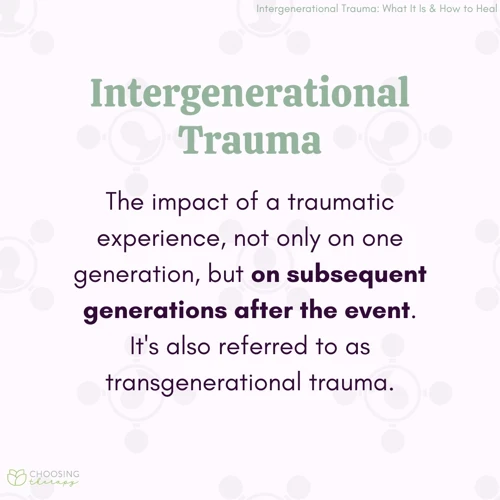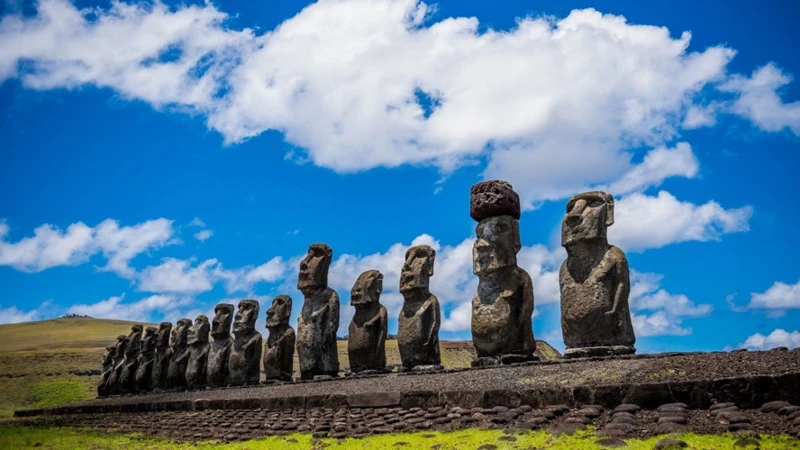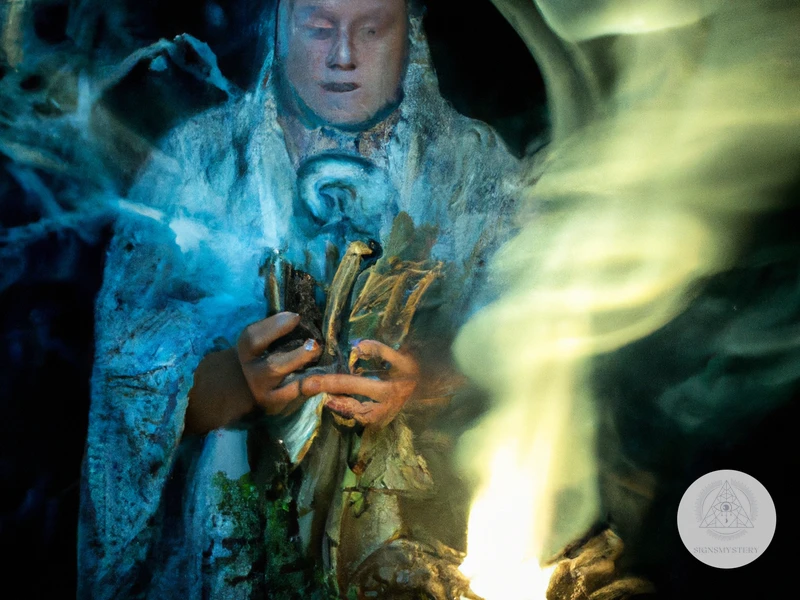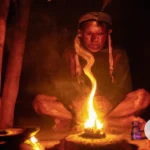For many of us, the challenges and struggles we face on a personal level are not solely our own. We may be carrying the weight of generational wounds and trauma that have been passed down to us from our ancestors. This is known as ancestral trauma. Shamanism, an ancient spiritual practice, offers an approach to healing that focuses on uncovering and addressing these inherited wounds. In this article, we will explore the concept of ancestral trauma and how shamanic healing can help us release these intergenerational burdens. We will also discuss the benefits of shamanic healing, as well as what to consider when choosing a shamanic practitioner for yourself or your family.
Understanding Ancestral Trauma

Understanding ancestral trauma is crucial to healing generational wounds. Ancestral trauma is the emotional pain and trauma that is passed down from one generation to another. It can manifest in many ways, including addiction, anxiety, depression, attachment issues, and relationship problems. Ancestral trauma affects us in ways we may not even be aware of, but it is essential to understand how it impacts us so we can begin the healing process. Shamanism is one way to address and heal ancestral trauma, using various techniques such as soul retrieval, spirit animal healing, and shamanic breathwork. By releasing the karmic debt of our ancestors, we can begin to uncover the roots of our struggles and heal not only ourselves but our whole family through generations.
What is Ancestral Trauma?
Ancestral trauma refers to traumatic experiences or events that have been passed down from previous generations. These experiences can be both emotional and physical and have a profound impact on our lives without us even being aware of it. This trauma can be stored in our DNA and cellular memory, causing us to experience negative emotions and physical symptoms that we can’t explain.
Ancestral trauma can be caused by a variety of events, including war, genocide, slavery, natural disasters, and other traumatic experiences that were experienced by our ancestors. This trauma can also be the result of unresolved emotional issues within a family such as abuse, addiction, or mental illness that has been passed down through generations.
Ancestral trauma is often a root cause of many negative patterns and behaviors in our lives. These patterns are often repeated, and we can feel stuck and unable to change them. They can cause us to feel anxious, depressed, or physically unwell, without understanding why.
Understanding ancestral trauma is an essential step towards healing. It is helpful to explore our family history and learn about any significant traumatic events that may have occurred. By recognizing and acknowledging the pain of our ancestors, we can begin to release the trauma that has been stored in our bodies and minds.
There are many effective shamanic healing techniques that can be used to help heal ancestral trauma. These techniques include soul retrieval, drumming, sound healing, plant medicine, and shamanic breathwork. These tools and practices are designed to help release negative energy, emotions, and physical symptoms that are associated with ancestral trauma.
Soul retrieval, for example, is a shamanic healing technique that involves retrieving lost parts of the soul that may have been lost due to traumatic experiences. Shamanic breathwork is another technique that uses the power of breath to release traumas stored in our bodies. Drumming and sound healing are also powerful tools that can be used to help release trauma and shift energy within the body.
Ancestral trauma is a significant issue that affects many of us, even if we are not aware of it. It can cause negative patterns and behaviors in our lives, leading to anxiety, depression, physical illnesses, and difficulties in relationships. However, by learning about ancestral trauma and using shamanic healing techniques to release it, we can begin to heal and live a more fulfilling and joyful life.
How Ancestral Trauma Impacts Us
Ancestral trauma is an inevitable part of human existence, passed down from generation to generation. The impact of ancestral trauma on our lives can be significant and pervasive. Those who have experienced intergenerational trauma may find themselves feeling inexplicable anxiety, depression, and despair. Research has shown that trauma can alter the expression of genes, leading to changes in how our brains and bodies function. Intergenerational trauma can also lead to the development of post-traumatic stress disorder (PTSD) and other mental health issues.
Additionally, studies have shown that trauma is often transferred to future generations through attachment relationships. Traumatized parents may struggle to form healthy emotional bonds with their children, leading to a cycle of generational trauma. The psychological impact of ancestral trauma can therefore be profound and long-lasting, changing the course of our lives and relationships.
However, there are ways to address the impact of ancestral trauma through shamanic healing. Shamanism is an ancient spiritual practice that recognizes the interconnectedness of all living things. Through shamanic practices such as sound healing, plant medicine, soul retrieval, and spirit animal healing, practitioners can access the roots of our ancestral trauma and help us to release it.
The releasing of ancestral trauma can also be facilitated by shamanic breathwork, energy healing, drumming, and transformative journeying. These techniques work by accessing the subconscious mind, allowing us to work through ancestral patterns and let go of unhealthy behaviors and emotional blockages.
Intergenerational trauma can have a profound impact on our mental, physical, and emotional health. Fortunately, shamanic healing can help us to address these issues and release the patterns of trauma that we have inherited. By working with a skilled shamanic practitioner, individuals can access deeper parts of themselves and begin to heal from the inside out. With the support of shamanic healing, those facing ancestral trauma can find a path towards greater wholeness, healing, and balance.
How Ancestral Trauma is Carried Across Generations
Ancestral trauma, also known as transgenerational trauma, is passed down from one generation to the next. Traumatic experiences from the past can leave a lasting impact on a person’s mental, emotional, spiritual, and even physical health. When left unaddressed, this trauma can affect future generations in a variety of ways.
One way that ancestral trauma is carried across generations is through epigenetics. Epigenetics is the study of how our genes can be influenced by environmental factors, such as experiences and traumas. Traumatic experiences can activate certain genes that can be passed down to future generations. This means that the trauma experienced by our ancestors can actually be imprinted on our DNA and affect our physical and emotional well-being.
Another way that ancestral trauma is carried across generations is through learned behavior. Children often learn from their parents and caregivers how to regulate their emotions and cope with stress. If a parent or grandparent experienced trauma and did not receive proper treatment or support, they may have unhealthy coping mechanisms that they pass down to their children. This can lead to a cycle of unresolved trauma and maladaptive coping behaviors that continue to be passed down through generations.
It is important to address ancestral trauma in order to prevent it from being passed down to future generations. Shamanic healing can be a powerful tool in breaking the cycle of transgenerational trauma. By working with ancestral spirits and healing the wounds of our ancestors, we can heal ourselves and our families.
If addiction is one of the ways that ancestral trauma is being carried across generations in your family, consider seeking out shamanic healing for addiction. Shamanic practitioners can help you address the root cause of addictive behaviors and work to heal the trauma that may be driving these patterns.
Shamanic Healing for Ancestral Trauma
Shamanic healing is a powerful method for addressing ancestral trauma and healing generational wounds. By working with spiritual guides and ancestral spirits, a shamanic practitioner can help individuals identify and release the energetic imprints of trauma that have been passed down through their ancestral lineages. Using various shamanic techniques such as soul retrieval, power animal retrieval, and ancestral healing, a shamanic practitioner can help individuals heal their connections to their ancestry and access the wisdom and support of their ancestors. The benefits of shamanic healing for ancestral trauma include healing the whole family through generations, releasing the karmic debt of our ancestors, and uncovering the roots of our personal struggles. When choosing a shamanic practitioner for ancestral healing, it is important to look for someone who has a deep understanding of ancestral trauma and who follows ethical guidelines for working with spiritual guides and ancestral spirits.
How Shamanism Addresses Ancestral Trauma
Shamanism is a holistic healing practice that offers unique tools to address ancestral trauma. Here are some of the ways in which shamanism can address this issue:
- Connecting with Ancestral Spirits: Shamans believe that our ancestors continue to watch over us and guide us. By building a relationship with our ancestors through shamanic journeying or other techniques, we can receive guidance for healing ancestral trauma.
- Healing the Lineage: In shamanism, it is believed that healing can happen not just for ourselves, but also for our ancestors and future generations. By working with ancestral spirits, shamans can heal the lineage of trauma and promote healing for all those affected.
- Releasing Stuck Energy: Shamanic healing techniques, such as soul retrieval or extraction, can help release stuck energy and emotions that may have been passed down through generations. This can help break the cycle of trauma and promote healing.
- Working with Nature: Shamans often work with nature and the elements in their healing practices. This connection to nature can help bring balance and harmony to the body, mind, and spirit, which is important for healing ancestral trauma.
By addressing ancestral trauma through shamanism, individuals can begin to heal themselves and contribute to the healing of their family lineage and future generations. It is important to work with a trained shamanic practitioner who can guide you through this process and provide a safe and supportive environment for healing.
Shamanic Healing Techniques for Ancestral Trauma
Shamanic healing techniques for ancestral trauma are numerous, and they all aim to alleviate the emotional and physical pain caused by generational wounds. One of the most common techniques is soul retrieval, which involves retrieving fragmented parts of the soul that have been lost due to trauma. The shaman engages in a journey to the spirit world to retrieve the lost soul parts and reintegrate them into the person’s being. This process can create a sense of empowerment and wholeness, helping to dislodge deep-seated trauma.
Another shamanic technique for ancestral trauma healing is energy clearing, which involves the extraction of negative energies and intrusive spirits that may be causing emotional, spiritual or physical distress in an individual. By implementing ancient rituals and ceremony, the shaman can help extract these blockages, creating more balance and harmony for the person being treated.
Shamanic practitioners also use plant medicines in their healing work. Ayahuasca, for example, is a powerful plant medicine that has been used for centuries by Amazonian shamans to heal trauma and other conditions. Ayahuasca can help an individual release emotional blockages, gain insights and awareness, and develop a deeper understanding of their ancestral and spiritual roots.
Another technique used by shamans to heal ancestral trauma is ritual. Rituals can be performed to release negative ancestral patterns and create new positive ones. These rituals can be performed for the individual, for the family, the community and even for the ancestors themselves.
Shamanic healing techniques for ancestral trauma can be powerful and transformative. With the guidance of a skilled shamanic practitioner, ancestral trauma can be transformed, and people can move towards a more fulfilling life. These techniques offer an alternative healing process that goes beyond what traditional therapy can provide. It is important to seek out a qualified and experienced shamanic practitioner to experience the full benefits of this healing tradition.
Shamanic Tools for Releasing Ancestral Wounds
Shamanic healing acknowledges that ancestral trauma can result in physical, emotional, and spiritual blockages that must be released for true healing to occur. There are various shamanic tools and techniques used to release these blockages and heal ancestral wounds.
One powerful tool for ancestral healing is ancestral offerings. These offerings can include herbs, tobacco, flowers, and other items that hold spiritual significance. By making offerings to our ancestors, we honor their legacy and seek their guidance and support in releasing their trauma.
Another tool used in shamanic healing is ancestral altar building. This involves creating a sacred space in your home devoted to honoring your ancestors. It can include photos, candles, and other items that carry personal significance. By creating an ancestral altar, we invite our ancestors to communicate with us and help guide us towards healing.
Shamans also use journeying to connect with their ancestors and heal ancestral wounds. Journeying involves entering an altered state of consciousness through drumming, chanting, or meditation. Journeying to the spiritual realm can help us understand the root causes of our ancestral trauma and gain insight into how to release it.
Shamans may use energetic healing techniques such as soul retrieval, extraction, and psychopomp work to release ancestral wounds. Soul retrieval involves calling back fragmented parts of ourselves that were lost due to trauma. Extraction is the removal of negative energy or spiritual intrusions that block our path to healing. Psychopomp work involves guiding the souls of our ancestors to their final resting place to resolve any unfinished business.
Shamanic tools can be incredibly effective in releasing ancestral wounds and bringing healing to ourselves and our family lines. By working with our ancestors in the spirit realm, we can tap into a deep well of wisdom and healing that can transform our lives.
Benefits of Shamanic Healing for Ancestral Trauma

Shamanic healing techniques provide numerous benefits for those seeking to heal their ancestral trauma. By addressing the underlying causes of generational wounds, shamanism can help individuals heal the whole family through generations. This healing process can also lead to the release of the karmic debt of our ancestors, providing a sense of freedom and release from past traumas. By uncovering the roots of our personal struggles, we can gain a deeper sense of self-awareness and understanding, which can ultimately lead to greater healing and personal growth. When choosing a shamanic practitioner, individuals should look for someone who has experience working with ancestral trauma and who can provide a safe and nurturing space for healing to occur. Shamanic healing can offer a powerful path to healing ancestral wounds and finding greater peace and understanding within ourselves and our relationships.
- Benefits: Healing the whole family through generations
- Benefits: Releasing the karmic debt of our ancestors
- Benefits: Uncovering the roots of our personal struggles
- Tips: Look for a shamanic practitioner experienced in ancestral trauma
- Tips: Seek a safe and nurturing space for healing to occur
Healing the Whole Family Through Generations
Through shamanic healing, the wounds of our ancestors can be released and the whole family can be healed through generations. Ancestral trauma can create patterns of dysfunction and pain that are passed down from one generation to the next. These patterns can manifest as physical, emotional, or mental health issues that affect every member of the family. However, when we connect with our ancestors through shamanic practices, we create an opportunity to heal the entire family lineage.
Shamanic healing helps to break the cycle of trauma by addressing not only the symptoms but also the root cause of the problem. A skilled shamanic practitioner can help to identify the energetic blockages that are preventing the flow of healing energy throughout the family line. By working with spirit guides, ancestors, and other divine forces, the practitioner can facilitate the release of toxic energy and help to restore balance
Subscribe to Our Newsletter
Sign up to receive the latest news and updates.
Healing the whole family through generations is a powerful and transformative process that can have a positive impact on all aspects of a person’s life. By releasing the energetic imprints of ancestral trauma, we can begin to experience greater levels of vitality, joy, and well-being. We can also begin to cultivate healthier relationships, both with ourselves and with the people in our lives.
It’s important to note that shamanic healing is not a substitute for professional medical or mental health treatment. However, it can be a powerful complement to other forms of therapy, and it can help to facilitate deeper levels of healing and transformation. If you are struggling with issues related to ancestral trauma, it’s important to seek out a qualified shamanic practitioner who can guide you through the healing process and help you to release the wounds of the past. Through shamanic healing, we can honor our ancestors, break free from negative patterns, and create a brighter future for ourselves and for generations to come.
Releasing the Karmic Debt of Our Ancestors
Releasing the Karmic Debt of Our Ancestors is one of the benefits of shamanic healing for ancestral trauma. According to shamanic beliefs, our ancestors’ unresolved traumas and negative actions can create a karmic debt that is passed down through generations, affecting our lives today. Shamanic healing techniques aim to release this debt and allow us to break free from the patterns of our ancestors.
One way to release the karmic debt of our ancestors is through a shamanic practice called “ancestral healing.” In this practice, a shamanic practitioner communicates with the spirits of our ancestors to identify any imbalances or negative patterns that are affecting our lives. This could include patterns of addiction, poverty, illness, or even relationship issues. Once the negative patterns are identified, the shamanic practitioner works with the ancestors to address and heal the issues.
Another technique used in shamanic healing for ancestral trauma is “ancestor reverence.” This involves honoring our ancestors through ritual and ceremony, thanking them for their positive contributions to our lives and asking for forgiveness for any negative actions that may have been passed down through generations. Through this practice of ancestor reverence, we can connect with our ancestors in a positive way and release the negative patterns that have been affecting us.
It’s important to note that releasing the karmic debt of our ancestors does not mean denying or ignoring their negative actions. Instead, shamanic healing acknowledges the negative patterns and works to address them in a way that is both respectful to our ancestors and helps us to move forward in a positive way.
Releasing the karmic debt of our ancestors is an important benefit of shamanic healing for ancestral trauma. By acknowledging and working to heal the negative patterns that have been passed down through generations, we can break free from the limitations of our ancestors and create a brighter future for ourselves and generations to come.
Uncovering the Roots of Our Personal Struggles
Uncovering the roots of our personal struggles is a crucial aspect of shamanic healing for ancestral trauma. Many times, the emotional and psychological issues that we face in our personal lives are deeply rooted in the traumas experienced by our ancestors. These traumas can manifest in a number of ways, such as anxiety, depression, addiction, relationship problems, and even physical ailments.
Through shamanic healing, we can access the spiritual realm to gain insights into the underlying causes of our struggles. Shamanic practitioners use various techniques like journeying, dreamwork, and divination to help their clients connect with their ancestors and receive guidance on how to heal their own personal wounds.
One of the key ways that shamanic healing uncovers the roots of our personal struggles is by addressing intergenerational trauma. This refers to the trauma that has been passed down through the generations as a result of historical injustices such as colonization, slavery, war, and genocide. By connecting with our ancestors, we can better understand the impact of these traumas on our family lineage and begin to break the cycle of pain and suffering.
Another way that shamanic healing helps us uncover the roots of our personal struggles is by revealing our soul’s purpose. Many times, the challenges we face in life are actually opportunities for growth and evolution. By working with a shamanic practitioner, we can gain clarity on our life path and learn how to align our personal purpose with that of our ancestors.
Ultimately, shamanic healing for ancestral trauma is about bringing healing and wholeness to our lives, our families, and our communities. By uncovering the roots of our personal struggles and addressing the traumas of our ancestors, we can create a brighter future for ourselves and for generations to come.
Choosing a Shamanic Practitioner
Choosing the right shamanic practitioner is crucial when seeking healing for ancestral trauma. Do your research and look for someone who has a solid understanding of shamanism and its principles. Look for someone who is experienced in working with ancestral trauma and has a proven track record of success. Trust your instincts when interacting with potential practitioners, as it’s essential to feel comfortable with the person who will be supporting you through your healing journey. Ensure that the practitioner is trained in shamanic techniques and is certified to practice. Additionally, consider factors such as fees, location, and availability. A reputable shamanic practitioner will be forthcoming and transparent about their qualifications and services. Remember, your healing journey is unique, and it’s essential to find a practitioner who resonates with your needs to foster a successful healing process.
What to Look for in a Shamanic Practitioner
When choosing a shamanic practitioner to help with ancestral trauma, there are certain qualities and characteristics to look for. Here are some important factors to consider:
| Qualities | Why it Matters |
|---|---|
| Experience | Look for someone who has experience in the specific areas you need help with, such as ancestral healing and shamanic journeying. |
| Integrity | Choose a practitioner who operates with high integrity and ethical standards, ensuring that they will work in your best interest. |
| Compassion | A shamanic practitioner who has a deep level of compassion and empathy can help you feel safe and held during your healing journey. |
| Open-mindedness | It is important to find a practitioner who is open-minded and non-judgmental, to allow for a safe and comforting space for you to heal. |
| Active Listening Skills | A practitioner with active listening skills can help you feel heard and understood, which can lead to a more effective and inspired healing session. |
| Training and Certifications | Look for a practitioner who has completed comprehensive training and has relevant certifications, ensuring that they are qualified to provide effective treatment. |
By choosing a shamanic practitioner who possesses these qualities and characteristics, you can ensure that you are working with someone who can help guide you towards healing and releasing ancestral trauma.
What to Expect in a Shamanic Healing Session
When going to a shamanic healing session for ancestral trauma, there are a number of things that one might expect. Firstly, the shamanic practitioner will likely create a safe space in which the patient can feel secure and at ease. This might involve lighting candles or incense, playing soothing music, or using other sound healing tools such as singing bowls or chimes.
The practitioner might then engage in a discussion with the patient, asking them to describe the issues they are facing and what they hope to achieve through the session. It is important to note that while the patient’s input is valuable in setting the intention of the session, the shamanic practitioner is ultimately the one guiding the healing process.
Once the intention has been set, the shamanic practitioner will likely enter into a state of trance or altered consciousness, often through the use of drumming or other rhythmic sounds. In this state, they are able to access the spiritual realm where the patient’s ancestral wounds may be stored.
Through the use of shamanic techniques such as soul retrieval, ancestral healing, or cord cutting, the practitioner may work to release the emotional and energetic blocks that are contributing to the patient’s ancestral trauma. This process can be transformative and may involve intense emotions or physical sensations.
It is important to note that while shamanic healing can be incredibly powerful, it is not a quick fix or magic bullet solution. It can take time and multiple sessions to fully release and heal ancestral wounds. However, with commitment and dedication, shamanic healing can be a powerful tool in addressing generational trauma and promoting overall wellbeing.
Conclusion
In conclusion, shamanic healing has been proven to be an effective way of addressing ancestral trauma and breaking the cycle of generational wounds. By tapping into the spiritual realm and connecting with our ancestors, shamanic practitioners can help us release the emotional burdens and negative energy that have been passed down through our family history.
Shamanism offers a unique approach to healing that is different from traditional therapy or modern medicine. Instead of just treating symptoms, it seeks to uncover the root cause of the problem and address it at its source. By doing so, it allows for a deep level of healing and transformation that can have profound and long-lasting effects.
If you are struggling with ancestral trauma, consider seeking the help of a qualified shamanic practitioner. Look for someone who has experience working with this type of healing and who resonates with you on a personal level. Be open-minded and willing to do the work necessary to heal yourself and your family.
Remember, healing is a journey, not a destination. It is a process of uncovering and releasing the layers of pain, fear, and trauma that have been holding you back from experiencing true joy and fulfillment in life. By embracing shamanic healing and the wisdom of our ancestors, we can break free from the patterns of the past and create a brighter, more hopeful future for ourselves and generations to come.
Frequently Asked Questions
What is the connection between Shamanism and Ancestral Healing?
Shamanism is based on the belief that everything is interconnected, including our ancestors and their experiences. Shamanic healing for ancestral trauma involves connecting with our ancestors and healing their wounds to release their impact on us.
Can Ancestral Trauma affect our daily lives?
Yes, ancestral trauma can manifest in our lives through unexplained fears, anxieties, and limiting beliefs. It can also impact our relationships, health, and career.
Is Shamanic Healing a substitute for professional medical help?
No, Shamanic Healing is not a substitute for professional medical care. It can be used as a complementary therapy to support healing and is best practiced under the supervision of a licensed healthcare professional.
How can I find a reputable Shamanic practitioner?
It’s important to do your research and choose a Shamanic practitioner who has completed a training program and has experience working with ancestral trauma. Ask for referrals and read reviews before making a decision.
Do I need to have a specific belief system to benefit from Shamanic Healing?
No, Shamanic Healing is not dependent on any particular religion or belief system. It is based on the belief that energy is all around us and can be used to promote healing.
Can Shamanic Healing be done remotely?
Yes, Shamanic Healing can be done remotely. Distance doesn’t matter since Shamanic healing is based on energy work and does not require physical proximity.
What can I expect during a Shamanic Healing session?
A Shamanic Healing session typically involves an initial consultation, followed by a series of Shamanic techniques to heal ancestral trauma. This can include visualization, guided meditation, and energy work.
Is it possible to heal my ancestors’ trauma without knowing what it is?
Yes, it is possible to heal ancestral trauma without knowing the specific details of what happened. Shamanic practitioners can connect with the energy of your ancestors and release the trauma without knowing the specific events.
How long does it take to see results from Shamanic Healing?
The results from Shamanic Healing can vary, and there is no set timeline. Some people experience immediate relief, while others need more sessions to see progress. It’s important to be patient and trust the process.
Can I heal my own ancestral trauma without a Shamanic practitioner?
It’s possible to do ancestral healing on your own, but working with a Shamanic practitioner can provide a deeper level of healing and support. A trained practitioner can guide you through the process and help you release ancestral trauma more effectively.










